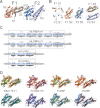Crystal and solution structures of Plasmodium falciparum erythrocyte-binding antigen 140 reveal determinants of receptor specificity during erythrocyte invasion
- PMID: 22989878
- PMCID: PMC3481285
- DOI: 10.1074/jbc.M112.409276
Crystal and solution structures of Plasmodium falciparum erythrocyte-binding antigen 140 reveal determinants of receptor specificity during erythrocyte invasion
Abstract
Erythrocyte-binding antigen 140 (PfEBA-140) is a critical Plasmodium falciparum erythrocyte invasion ligand that engages glycophorin C on host erythrocytes during malaria infection. The minimal receptor-binding region of PfEBA-140 contains two conserved Duffy binding-like (DBL) domains, a fold unique to Plasmodium species. Here, we present the crystal structure of the receptor-binding region of PfEBA-140 at 2.4 Å resolution. The two-domain binding region is present as a monomer in the asymmetric unit, and the structure reveals novel features in PfEBA-140 that are likely determinants of receptor specificity. Analysis by small-angle x-ray scattering demonstrated that the minimal binding region is monomeric in solution, consistent with the crystal structure. Erythrocyte binding assays showed that the full-length binding region containing the tandem DBL domains is required for erythrocyte engagement, suggesting that both domains contain critical receptor contact sites. The electrostatic surface of PfEBA-140 elucidates a basic patch that constitutes a putative high-affinity binding interface spanning both DBL domains. Mutation of residues within this interface results in severely diminished erythrocyte binding. This study provides insight into the structural basis and mechanism of PfEBA-140 receptor engagement and forms a basis for future studies of this critical interaction. In addition, the solution and crystal structures allow the first identification of likely determinants of erythrocyte receptor specificity for P. falciparum invasion ligands. A complete understanding of the PfEBA-140 erythrocyte invasion pathway will aid in the design of invasion inhibitory therapeutics and vaccines.
Figures




Similar articles
-
Critical glycosylated residues in exon three of erythrocyte glycophorin A engage Plasmodium falciparum EBA-175 and define receptor specificity.mBio. 2014 Sep 9;5(5):e01606-14. doi: 10.1128/mBio.01606-14. mBio. 2014. PMID: 25205096 Free PMC article.
-
Structural and functional basis for inhibition of erythrocyte invasion by antibodies that target Plasmodium falciparum EBA-175.PLoS Pathog. 2013;9(5):e1003390. doi: 10.1371/journal.ppat.1003390. Epub 2013 May 23. PLoS Pathog. 2013. PMID: 23717209 Free PMC article.
-
Structural basis for the EBA-175 erythrocyte invasion pathway of the malaria parasite Plasmodium falciparum.Cell. 2005 Jul 29;122(2):183-93. doi: 10.1016/j.cell.2005.05.033. Cell. 2005. PMID: 16051144
-
Disguising itself--insights into Plasmodium falciparum binding and immune evasion from the DBL crystal structure.Mol Biochem Parasitol. 2006 Jul;148(1):1-9. doi: 10.1016/j.molbiopara.2006.03.004. Epub 2006 Apr 4. Mol Biochem Parasitol. 2006. PMID: 16621067 Review.
-
Erythrocyte glycophorins as receptors for Plasmodium merozoites.Parasit Vectors. 2019 Jun 24;12(1):317. doi: 10.1186/s13071-019-3575-8. Parasit Vectors. 2019. PMID: 31234897 Free PMC article. Review.
Cited by
-
A Malaria Parasite Cross Reveals Genetic Determinants of Plasmodium falciparum Growth in Different Culture Media.Front Cell Infect Microbiol. 2022 May 30;12:878496. doi: 10.3389/fcimb.2022.878496. eCollection 2022. Front Cell Infect Microbiol. 2022. PMID: 35711667 Free PMC article.
-
Broadly neutralizing epitopes in the Plasmodium vivax vaccine candidate Duffy Binding Protein.Proc Natl Acad Sci U S A. 2016 May 31;113(22):6277-82. doi: 10.1073/pnas.1600488113. Epub 2016 May 18. Proc Natl Acad Sci U S A. 2016. PMID: 27194724 Free PMC article.
-
Sialic Acids as Receptors for Pathogens.Biomolecules. 2021 Jun 2;11(6):831. doi: 10.3390/biom11060831. Biomolecules. 2021. PMID: 34199560 Free PMC article. Review.
-
A sialic acid-binding protein in Toxoplasma gondii contains a conserved globular domain in apicomplexan parasites.Parasit Vectors. 2025 Jul 1;18(1):239. doi: 10.1186/s13071-025-06845-5. Parasit Vectors. 2025. PMID: 40598570 Free PMC article.
-
P. falciparum Invasion and Erythrocyte Aging.Cells. 2024 Feb 12;13(4):334. doi: 10.3390/cells13040334. Cells. 2024. PMID: 38391947 Free PMC article. Review.
References
-
- Cowman A. F., Crabb B. S. (2006) Invasion of red blood cells by malaria parasites. Cell 124, 755–766 - PubMed
-
- Lobo C. A., Rodriguez M., Reid M., Lustigman S. (2003) Glycophorin C is the receptor for the Plasmodium falciparum erythrocyte-binding ligand PfEBP-2 (baebl). Blood 101, 4628–4631 - PubMed
-
- Gilberger T. W., Thompson J. K., Triglia T., Good R. T., Duraisingh M. T., Cowman A. F. (2003) A novel erythrocyte-binding antigen 175 paralogue from Plasmodium falciparum defines a new trypsin-resistant receptor on human erythrocytes. J. Biol. Chem. 278, 14480–14486 - PubMed
Publication types
MeSH terms
Substances
Associated data
- Actions
Grants and funding
LinkOut - more resources
Full Text Sources
Other Literature Sources

